

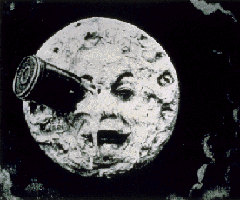 Still
photographs in the cinema; movie icons, dramatic and emotional stimulants.
Remember the scene from CASABLANCA where Bogey tells Ingrid Bergman
that she's getting on that plane? You know, the "We'll-always-have-Paris"
speech. How about the scene atop the Empire State building where King Kong
shakes his furious fists at the whirling bi-planes?
Still
photographs in the cinema; movie icons, dramatic and emotional stimulants.
Remember the scene from CASABLANCA where Bogey tells Ingrid Bergman
that she's getting on that plane? You know, the "We'll-always-have-Paris"
speech. How about the scene atop the Empire State building where King Kong
shakes his furious fists at the whirling bi-planes?
Of course you remember.
You remember the scenes from the films themselves, of course, but your recollection may be enhanced by a photograph, either shot by a still photographer or culled from the negative of the movie itself. These photographs, either by chance or intention have assumed an iconographic significance - in the best of all worlds they capture the essence of a movie, what it's about, or, more likely, (and significant), its emotional impact. In some cases, the still has altogether supplanted the memory of the film, as for example in the case Georges Melies' early sci-fi fantasy, TRIP TO THE MOON. Most contemporary movie-goers have never seen the Melies silent, but these same folk have no difficulty recognizing the still photograph from the movie, wherein the rocketship splats squarely in the man in the moon's eye. Similarly, film-Goers of today may never have seen W.C. Fields, but they all recognize the essence of Fields as captured in the still photo where he glowers from behind a hand of poker.
Before going any further, a caveat: because many of the wonderful moments in special-effects laden movies could never have been captured "on set" by a still photographer, but most come from the movie negative itself, I will not in the ensuing discussion limit my observations to production photographs. A production still could never have captured Kong threatening the bi-planes.
Some further reflections by way of preamble and ground rules. The difference between any kind of still photography and motion pictures, is the capturing, the freezing, if you will, of what one of my heroes, the great French photographer, Cartier-Bresson referred to as "the decisive moment," ie, the indefinable instant when subject and form come together in a image which transcends mere description and becomes poetry. One might even suggest that making motion pictures is everything leading up to those magically decisive moments.
What I enjoy about a good still photograph are the emotional memories it sparks, like Bogart and Bergman saying their farewells at the Casablanca airport. The image become a visual haiku to the film.
It seems almost happenstance when such an image finds enduring acceptance as a piece of cinematic iconography. For all the efforts of advertisers, the pictures that enter the pantheon of movie imagery, are rare and sometimes unintentional. Sometimes a particular still becomes the poster for the film as in the case of The Graduate, but more often, the lasting images surface after the film has come and gone.
When I produced GHOST, our editor, Walter Murch, introduced me to an intriguing use of still photos. Walter had a "key" still image made with his 35mm camera off a frame of the film's workprint for each camera set-up (angle). These stills were then enlarged and placed in sequence on a foam-core panel, creating an almost hieroglyphic progression, which Walter referred to as "hieroglyphs for a language of emotions". An entire film viewed iconographically!
In researching this piece, I was truly amazed at the poor selection of stills shown in movie reference books and CD's. I'm referring to the specific frame chosen for publication. While this is disconcerting to the cinefile, it also provides an ominous reminder of how many classic films have disappeared completely; in some cases it is only the still photograph that remains.
The photographs I have included here are
for the most part some of my favorites. Strand me on a desert island with
a solar powered laser disc and monitor and any of these titles and you
can send the Titanic to rescue me.
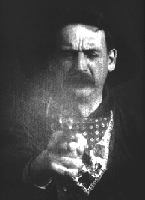 A
TRIP TO THE MOON (1902) Georges Méliès.
A
TRIP TO THE MOON (1902) Georges Méliès.
From 1897 to 1904 Méliès made hundreds of films, most are now lost. Méliès was George Lucas' ancestral soul mate.
Photo - The rocket ship impaled in the squinting moon.
THE GREAT TRAIN ROBBERY (1903) Edwin S. Porter
Photo - The train robber shooting
his revolver directly into camera. The power of the image literally had
people diving for cover in the theaters. It is one of the earliest recorded
icon stills.
 SAFETY
LAST (1923) - Harold Lloyd
SAFETY
LAST (1923) - Harold Lloyd
Surreal, almost Dali-esque with Harold Lloyd hanging from the hands of a huge clock. Most people take it for granted that Harold Lloyd actually performed this stunt himself and he had only one hand. The other was a prosthetic, the real one having been blown off while filming a stunt!
POTEMKIN (1925) - Sergei Eisenstein.
This tragic image has in time become a parody of itself. From Woody Allen to Brian DePalma filmmakers have found this an irresistible image.
Photo - From the "Odessa steps" sequence.
The baby carriage going down the steps.
LE
CHIEN ANDALOU (1928 ) Luis Buñuel.
Another icon from the dawn of surrealism
in the cinema. Created by two
masters; Salvador Dali and Luis Buñuel.
Photo - A man's hand holding a razor blade
about to slice through the eye.
THE GENERAL (1927) - Buster Keaton
A perfect image of Keaton's dead pan bravery
and his genius as a film maker.
Photo - Buster Keaton riding on the cow catcher of the locomotive.
THE PASSION OF JOAN OF ARC (1928) - Carl
Theodore Dreyer.
The actress's face expresses the essence
of Jeanne d'Arc's struggle. The director captured it on film.
Photo - Maria Falconett prepares to meet her death at the stake.
THE BLUE ANGEL (1930) Josef Von Sternberg
This still is one of the earliest icons
which immortalized Dietrich, top hats, garter belt, silk stockings, and
high heels. The fetish photo as icon.
Photo - Marlene Dietrich as Cabaret singer Lola Frohlich mesmerizes her audience with sexuality in the night club known as The Blue Angel
M (1931) - Fritz Lang's classic
Lorre's expression truly captures the
misery of self-paranoia.
Photo - Over Peter Lorre's shoulder in the mirror as he notices the "M" written in chalk on his back.
 THE
PUBLIC ENEMY (1931) William Wellman.
THE
PUBLIC ENEMY (1931) William Wellman.
Probably the most celebrated image of
domestic violence at the breakfast table.
Photo - James Cagney about to mash a grapefruit into Mae Clarke's face.
KING KONG (1933) - Merian C. Cooper
This has been made into millions of movie
posters, T-shirts... When you think of Kong, you think of this.
Photo - Kong atop the Empire State Building,
struggles against attacking Navy planes while Fay Wray lies helpless on
a ledge.
MODERN TIMES (1936) - Charles Chaplin
Before OSHA, Chaplin made factory safety
look like an e-ticket ride at an amusement park. The size of the gears
and the cut-away perspective give it a surreal quality as well as humor.
Photo - Side angle of Charlie Chaplin passing through the gears of a machine.
THE GRAND ILLUSION (1937) - Jean Renoir.
One could say that this image of Von Stroheim
as a civilized, German officer is a Grand illusion given the reputation
of the German military, but it's not the only one in the film.
Photo - Eric Von Stroheim as Von Rauffenstein buttoned literally to his chin in teutonic formality.
GONE WITH THE WIND (1939) - Victor Fleming
and others..
Gable was and remains for me, the archetypal
example of a movie star.
Photo - Clark Gable as he says, "Frankly,
my dear, I don't give a damn
MR. SMITH GOES TO WASHINGTON (1939) -
Frank Capra.
Here's an image of tormented innocence
that all politicians should try to measure up to, but won't.
Photo - James Stewart in the senate, hair disheveled after hours of filibustering.
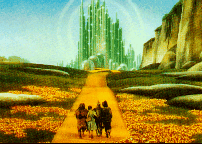 THE
WIZARD OF OZ (1939) Victor Fleming et al...
THE
WIZARD OF OZ (1939) Victor Fleming et al...
Fantastical image. It has become more American than apple pie.
Photo - Judy Garland, Jack Haley, Ray Bolger skipping along the Yellow Brick Road, off to see the wizard
CITIZEN KANE (1941) - Orson Welles
I'm about to take the fifth. After countless
viewings, it's so difficult to objectively say which single image represents
the movie for me, but probably when he was attacking Boss Jim Gettys. It's
not the most stunning image, there are many deep focus shots, with dramatic
cross lighting I prefer. Unfortunately, they don't sum up the movie.
Photo - Orson Welles standing at a podium gesturing in front of a gigantic poster of himself.
CASABLANCA
(1942) - Michael Curtiz
After at least fifty viewings of Casablanca,
this still makes me teary-eyed.
Photo - Bogart and Bergman at the Casablanca airport.
LES ENFANTS DU PARADIS (1948) Marcel Carné
This is one of the sexiest, non-graphic
sex scenes from any film.
Photo - A wide-eyed Jean-Louis Barrault, watching in anticipation as Arletty playing Garance unbuttons her blouse.
THE LADY FROM SHANGHAI (1948) Orson Welles
If you've seen the film, then you know
this is the prelude to one of the most dynamic shoot outs in cinema history.
And there weren't any digital effects to remove any unwanted reflections.
Photo - Orson Welles holding Rita Hayworth in the Hall of Mirrors sequence.
THE TREASURE OF THE SIERRA MADRE (1948)
- John Huston
He's sweaty, dirty, gun in hand looking
paranoid and dangerous. Makes you want to swig a bottle of Jack Daniels
and hide.
Photo - Bogart as Fred C. Dobbs
THE THIRD MAN (1949) - Carol Reed
Epitomizes the notion of what fun it is
to play the bad guy. Can you hear the zither?
Photo - Orson Welles's charming close-up from out of the shadows as Harry Lime.
WHITE HEAT (1949) - Raoul Walsh
One of two quintessential Cagney stills.
Photo - James Cagney as Arthur Cody Jarrett
sitting on his mother's lap.
 SUNSET
BLVD. (1950) - Billy Wilder
SUNSET
BLVD. (1950) - Billy Wilder
She is center of frame, photographers
all around her. Sunset Blvd is a perfect movie. They don't get any better
than this. I pray that wherever the negative is, that it's in good hands.
Photo - Gloria Swanson "All right, Mr.
De Mille, I'm ready for my close-up."
THE AFRICAN QUEEN (1951) - John Huston
You can almost feel the leeches sucking
their blood. Another perfect movie.
Photo - Bogart in the water pulling the
African Queen with Kathryn Hepburn.
STRANGERS ON A TRAIN (1951) - Alfred Hitchcock
This says everything about their relationship
and the clever plot idea of Bruno's, "Criss-cross. You do my murder, and
I'll do yours."
Photo - Low Angle wide two shot of
Robert Walker as Bruno Antony and Farley Granger as Guy Haines.
HIGH NOON (1952) - Fred Zinneman
An unmistakable icon. You feel the weight
of the world on Cooper's face and shoulders.
Photo - High down angle on Gary Cooper as he walks alone on the street - the emphasis is on alone.
SINGIN'
IN THE RAIN (1952) - Stanley Donnen
This photo captures Kelly's state of being 'Head over heels in love.'
Photo - Gene Kelly sings and dances, standing on a lamp post, arm outstretched holding an unopened umbrella.
THE WILD ONE (1954) - Laslo Benedek
Here's another example of a movie still
that represents the movie, but is also an icon of movie history. Another
image that has been made into millions of posters.
Photo - Brando straddling his Harley-Davidson.
THE SEVEN YEAR ITCH (1955) Billy Wilder
This is probably the only thing (image)
that anyone remembers from this movie - but what an image!
Photo - Marilyn Monroe standing on a subway grate. Tail winds (no pun) from a subway cause her dress to parachute up around her thighs.
THE NIGHT OF THE HUNTER (1955) -
Charles Laughton
Gives me chills just looking at it. The
movie was photographed by Orson Welles' other cinematographer, Stanley
Cortez (The Magnificent Andersons).
Photo - Robert Mitchum as Preacher Harry Powell showing his hands with Heaven and Hell spelled out.
THE SEARCHERS (1956) - John Ford
The last shot of the movie. John Wayne
as Ethan Edwards after bringing Natalie Wood home. This matches the opening
shot of the movie.
Photo - John Wayne silhouetted in the doorway, walks out into the bright sunlight.
THE BRIDGE ON THE RIVER KWAI (1957) - David
Lean
The action captured in this still is the
dramatic engine for the plot. From this point in the movie Guinness is
proud, stubborn, and defiant of the Japanese commander's agenda...that
is until he proves he can build a better bridge. Bookend this with
the shot at the end of Guinness realizing what he's done.
Photo - Alec Guinness being slapped by Sessue Hayakawa.
BREATHLESS - (1959) Jean Luc Goddard
This image upped the subscription drive
for the I.H.T. Also proved that a woman could look beautiful even with
short hair.
Photo - Jean Seberg hawking the International Herald Tribune on a Paris street.
SOME LIKE IT HOT (1959) Billy Wilder
It still shines brighter than anything
in Tootsie. Another perfect movie!
Photo -Tony Curtis and Jack Lemon in a two shot, as they walk in drag along the train platform.
NORTH BY NORTHWEST (1959) - Alfred Hitchcock
Unexpected and brilliant use of open space
creates extraordinary suspense. Others might argue that the shot of Grant
holding Eve Marie Saint's arm on the edge of Mount Rushmore is the key
shot.
Photo - Cary Grant as Roger Thornhill running through a barren field as a crop duster swoops down behind him.
LA DOLCE VITA (1959) Federico Fellini
This is not my favorite Fellini film,
but it has two Iconographic photos; the Christ statue hanging from a Helicopter.
This was actually quite a scandalous image in those days, and Anita Ekberg
in the Trevi.
Photo - Anita Ekberg in the Trevi fountain.
PSYCHO (1960) Alfred Hitchcock
This has to be in the top ten icon photos
of movie history.
Photo - Mother's Gothic mansion and Perkin's silhouette.
SHOOT THE PIANO PLAYER (1960) Francois
Truffaut
This captures Azanavour's anxiety and
tension. A great film!
Photo - Charles Aznavour as Piano Player, Charlie Koller.
LAWRENCE OF ARABIA (1962) - David Lean.
Another movie like Citizen Kane where
each frame could be a renowned icon. Another difficult challenge for me
- I've seen this at least thirty times or more and I have so many images
stored in my mind when I think of Lawrence. In an odd way it depends on
the mood I'm in. For example, I might think of the close-up of Peter O'toole
just prior to extinguishing the match (which is the outgoing cut of one
of the most exciting montage experiences in cinema history, as it cuts
to exterior dawn on the desert. )
Photo -It might be of Peter O'toole sweeping his arm into the air as he leads the charge over the sand dunes towards the train whose tracks he has just blown up. I was honored to trip over the remains of those tracks one morning in 1973 while scouting locations in Almeria, Spain on The Wind and the Lion.
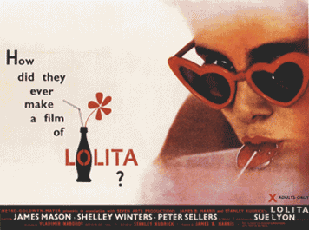 LOLITA
(1962) Stanley Kubrick
LOLITA
(1962) Stanley Kubrick
Icon status - a classic image of the cinema.
It embodies teen-age impurity.
Photo - Close up of Sue Lyon with her heart-shaped glasses draped over her nose.
8 1/2 (1963) - Federico Fellini.
Stylistically, this is one of the most
exquisite movies ever made. The camera floats through the sets using beautiful
wide angle lens and sumptuous black and white photography.
Photo - Marcello Mastroianni wearing a black hat with a white sheet wrapped around his waist and holding a bull whip.
BLOWUP (1966) - Michelangelo Antonioni
There's an interesting similarity to the
image used in The Graduate. Many Nikon F's were sold as a result of this
movie.
Photo - David Hemmings in B.G. With Vanessa Redgrave in F.G.
DR. STRANGELOVE OR: HOW I LEARNED TO STOP
WORRYING AND LOVE THE BOMB (1964) Stanley Kubrick
The war room set which President Ronald
Reagan wanted to see on his first visit to the Pentagon. He was incredulous
when told it didn't exist, except in the movie.
Photo - Peter Sellers as Dr. Strangelove, in the war room, struggling with his hand "Mein Fuhrer I can walk!"
THE
GRADUATE (1967) Mike Nichols
Here's an example of a great image that
became the poster for the film.
Photo - Dustin Hoffman in the b.g., Ann
Banchroft's leg displayed in all of
it's sexual beauty horizontally in the
foreground.
ROSEMARY'S BABY (1968) - Roman Polanski
Polanski's first American movie. This
film has one of the best dream sequences produced in a Hollywood made film.
Photo - Mia Farrow (low angle) reacting to her infant son, the child of Satan in its baby carriage.
2001 (1968) Stanley Kubrick
Probably the most cinematic movie ever
made. Other than a silent film, this is the only movie that doesn't have
or need a word of spoken dialogue for the first twenty-six minutes.
One of the greatest movie ever made.
Photo - Interior space pod. Gary Lockwood & Keir Dullea discuss the need to disconnect the HAL 9000 computer, unaware that HAL can lip-read their conversation.
Icon shot - Wide tableau barren plains - shot of an ape tossing a bone into the dawn sky.
THE WILD BUNCH (1969) - Sam Peckinpah
The celebrated violence in this movie
was a cause celebre when it opened. Years later it can be appreciated as
simply a great character driven epic.
Photo - 'The Walk" Ben Johnson, Warren Oates, William Holden, Ernest Borgnine all armed, march down a dusty western street leaving the 19th century behind.
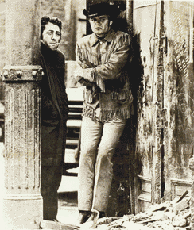 MIDNIGHT
COWBOY (1969) - John Schlesinger
MIDNIGHT
COWBOY (1969) - John Schlesinger
New York is America. In this single image,
in addition to its stars, you recognize the melting pot of humanity. John
Schlesinger's movies are so under appreciated it's a crime. The acting
is always top notch and cinematically they are impeccable. Check out,
DARLING.
Photo - Dustin Hoffman (Ratso Rizzo) and Jon Voight (Joe Buck) walk down 5th Ave.
PATTON (1970) - Franklyn Schaffner
General George S. Patton, played by George
C. Scott delivers an impassioned speech. There's a great still from the
scene where he slaps a soldier in a tent hospital, knocking his helmet
off. Interesting parallels to the going's on in Washington D.C. The
slap, a seemingly unimportant event destroyed Patton's brilliant career
as a General.
Photo - Saluting his troops in the
opening scene before a gigantic American flag,
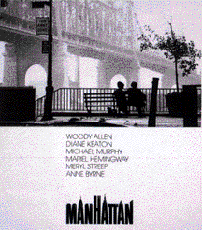 MANHATTAN
(1979) - Woody Allen
MANHATTAN
(1979) - Woody Allen
Here's a great image from a great movie which is also the poster.
Photo - Wide shot behind Woody Allen and
Diane Keaton sitting on a bench as they watch the sun rise over the fifty-ninth
Street Bridge. Gershwin soars...
You've reached the end of my collection,
my exhibit of movie stills. There are many more and each time I think I've
finished, I recall others that have been left off. The point is, these
are some of the photographs that are imbedded in the universal subconscious
of cinefiles - especially, yours truly. I hope you have enjoyed your visit.
S.C. Jaffe
Pacific Palisades, California © 1998
Steven-Charles Jaffe is a Producer and Director, with five Academy Award nominations.
Among the honors his films have earned are five Academy Award nominations for GHOST, including Best Picture. It also received four Golden Globe nominations, and won The People's Choice Award for Best Picture. Jaffe has won four Saturn Awards for Best Picture: TIME AFTER TIME, NEAR DARK, GHOST, and STAR TREK VI. STRANGE DAYS was nominated for four Saturn Awards, including Best Picture.
Jaffe had a camera in his hands by the age of seven when he began to express himself visually, and has remained an avid and passionate photographer for more than thirty years. His photograph of legendary Hollywood photographer Phil Stern is one of the centerpieces of the book, A DAY IN THE LIFE OF HOLLYWOOD. Jaffe was Second Unit Director on THE DAY AFTER, A photograph from one of Jaffe's sequences was used for the cover of Newsweek.. Jaffe's body of work established him as one of the most creative and versatile film makers in the movie industry.
| Contents | Editorial | The Platypus | Links | Copyright |
| Feature | Camera Corner | War Stories | Dirck's Gallery | Comments |
| Archives | Columns | Forums | Mailing List |